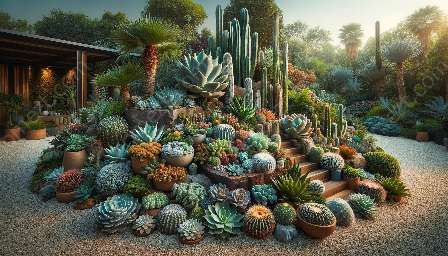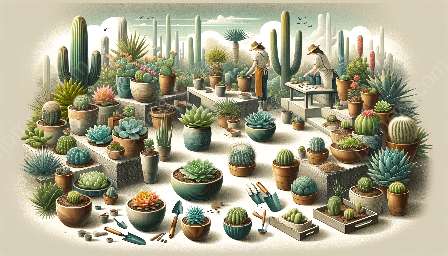When creating a succulent and cacti garden, understanding their native habitats and ecology is essential for effectively cultivating and designing spaces that support these unique plants. This topic cluster offers a comprehensive exploration of the natural environments in which succulents and cacti thrive, providing insights into how these plants have adapted to their ecosystems and how gardeners can recreate suitable conditions for them.
The Diversity of Succulents and Cacti
Succulents and cacti are known for their remarkable ability to thrive in arid and semi-arid environments, from deserts to mountainous regions. The diversity of succulents and cacti is vast, with thousands of species found across different continents, each uniquely adapted to its native habitat.
The Origins of Succulents and Cacti
Succulents and cacti have evolved in diverse environments around the world, including the Americas, Africa, and parts of Asia. Their ability to store water in their fleshy leaves, stems, or roots allows them to survive in regions with limited rainfall and extreme temperature variations.
Adaptations to Arid Environments
Understanding the ecological adaptations of succulents and cacti is crucial for successfully growing these plants in garden settings. Their ability to minimize water loss through specialized photosynthesis processes and modified leaf structures allows them to thrive in harsh conditions.
Natural Habitats of Succulents and Cacti
Succulents and cacti can be found in a wide range of natural habitats, including deserts, rocky slopes, coastal areas, and high-altitude plateaus. Each habitat presents unique challenges and opportunities for these plants, shaping their growth patterns and physical characteristics.
Desert Environments
Desert-dwelling succulents and cacti have evolved mechanisms to cope with intense sunlight, infrequent rainfall, and temperature extremes. Their shallow root systems allow them to quickly absorb water after rare rain events, while their ability to store water helps them survive extended dry periods.
Mountainous Regions
In high-altitude environments, succulents and cacti have adapted to cooler temperatures and fluctuating moisture levels. Some species thrive in rocky terrain, using their compact growth forms to withstand winds and harsh weather conditions.
Coastal Areas
Succulents and cacti found in coastal areas have developed unique adaptations to saline soils and oceanic climates. Their ability to tolerate salt spray and strong winds distinguishes them from species found in other environments.
Ecological Interactions and Conservation
Exploring the ecological relationships between succulents, cacti, and other organisms sheds light on the importance of these plants in their native habitats. From providing food and shelter for wildlife to contributing to the conservation of biodiversity, succulents and cacti play critical roles in their ecosystems.
Wildlife and Pollinators
Succulents and cacti attract a variety of wildlife, including insects, birds, and mammals, which rely on these plants for nourishment and nesting sites. The unique flowers of many succulents and cacti have co-evolved with specialized pollinators, contributing to the intricate web of ecological interactions in their habitats.
Conservation Challenges
As human activities and climate change pose increasing threats to natural habitats, the conservation of succulents and cacti has become a pressing concern. Understanding the ecological needs of these plants is crucial for developing effective conservation strategies, both in their native environments and in cultivated gardens.
Gardening with Succulents and Cacti
Applying the knowledge of native habitats and ecological adaptations, gardeners can create diverse and resilient landscapes with succulents and cacti. By mimicking the conditions found in their natural habitats, individuals can establish thriving gardens that celebrate the beauty and resilience of these plants.
Design Considerations
Integrating succulents and cacti into garden designs involves considering factors such as sunlight exposure, soil composition, and water drainage. Embracing the unique characteristics of different species allows for the creation of visually captivating and ecologically sustainable landscapes.
Water-Wise Landscaping
The water-storing capabilities of succulents and cacti make them ideal choices for water-wise landscaping, especially in regions prone to drought. By using native and adapted species, gardeners can reduce water consumption while supporting local biodiversity.
Community and Educational Gardens
Engaging in community and educational gardens focused on succulents and cacti offers opportunities to share knowledge about the ecological importance of these plants and inspire a deeper appreciation for their native habitats.
















